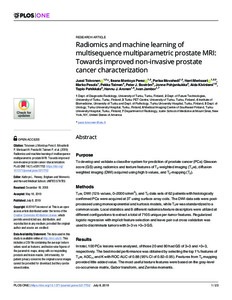Radiomics and machine learning of multisequence multiparametric prostate MRI: Towards improved non-invasive prostate cancer characterization
Harri Merisaari; Marko Pesola; Aida Kiviniemi; Jonne Pohjankukka; Hannu J. Aronen; Pekka Taimen; Jussi Toivonen; Tapio Pahikkala; Ileana Montoya Perez; Parisa Movahedi; Peter J. Boström; Ivan Jambor
https://urn.fi/URN:NBN:fi-fe2021042827450
Tiivistelmä
Purpose
To
develop and validate a classifier system for prediction of prostate
cancer (PCa) Gleason score (GS) using radiomics and texture features of T2-weighted imaging (T2w), diffusion weighted imaging (DWI) acquired using high b values, and T2-mapping (T2).
Methods
T2w, DWI (12 b values, 0–2000 s/mm2), and T2
data sets of 62 patients with histologically confirmed PCa were
acquired at 3T using surface array coils. The DWI data sets were
post-processed using monoexponential and kurtosis models, while T2w
was standardized to a common scale. Local statistics and 8 different
radiomics/texture descriptors were utilized at different configurations
to extract a total of 7105 unique per-tumor features. Regularized
logistic regression with implicit feature selection and leave pair out
cross validation was used to discriminate tumors with 3+3 vs >3+3 GS.
Results
In
total, 100 PCa lesions were analysed, of those 20 and 80 had GS of 3+3
and >3+3, respectively. The best model performance was obtained by
selecting the top 1% features of T2w, ADCm and K with ROC AUC of 0.88 (95% CI of 0.82–0.95). Features from T2
mapping provided little added value. The most useful texture features
were based on the gray-level co-occurrence matrix, Gabor transform, and
Zernike moments.
Conclusion
Texture feature analysis of DWI, post-processed using monoexponential and kurtosis models, and T2w
demonstrated good classification performance for GS of PCa. In
multisequence setting, the optimal radiomics based texture extraction
methods and parameters differed between different image types.
Kokoelmat
- Rinnakkaistallenteet [27094]
